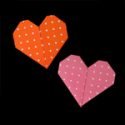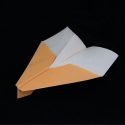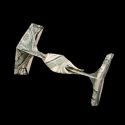Origami Stories & Poems
– the folder and the receiver;
– the writer and the reader.
Here, we have a collection of origami stories and poems. Enjoy them but please do not repost or distribute them without the authors permission. The works are protected by copyright laws.
Origami Poems
- Origami author unknown
- A Folders Philosophy by Harold J. Graham
- origami life by B.Sue Johnson
- Poem of Origami by TP Kong
- Poems, Haiku and Verses by John Smith
Stories
- Folding Paper by B.Sue Johnson
Origami Story Books
- The Origami Master by Lachenmeyer and Sogabe
- Fold Me A Poem by O’Connell George & Stringer
- Butterflies for Kiri by Cathryn Falwell
- Pink Paper Swans by Virginia L. Kroll
- Yoko’s Paper Cranes by Rosemary Wells
- Little Oh by Laura Krauss Melmed, Jim LaMarche
- The Paper Crane Crane by Molly Bang
- Plant Parts Smarts by Eric Braun
Origami author unknown
What gentle art to confine
By plane of paper – folded line.
What magic here to capture me.
In infinite variety.
Shape on shape and fold on fold
Creates a world from simple mold.
In what emerges my eye can see
Bird or beast or geometry.
The art’s not in the form that is won alone
But also in the journey done.
Through plane of paper and folded line
A glimpse of eternity is mine.
What gentle art to confine
By plane of paper – folded line
What magic here to capture me,
In infinite variety
Poem was submitted to Origami Resource Center by Rosemary Browne.
Back to the top
A Folders Philosophy by Harold J. Graham
Every life is like a square.
Every choice is like a fold.
The folds we make we become.
Every mountain is a valley when viewed from the other side.
Some folds we must make
Over,
And over,
And over,
And over again.
Not because we did it wrong the first time,
But because that’s what it takes to get there.
Some of the folds are so deeply set that, though we never see them,
they shape the finest of details to those who see us.
Every square has the same potential to be something simple, or very
complex,
But both are necessary.
Both are beautiful.
And the square which is
Bent,
Crushed,
Discarded of man,
Can be reopened.
Its folds are soft.
It’s texture rich.
It’s willingness to be is unsurpassed.
Harold J. Graham teaches origami as part of his Career and Technology Education program. He is writing a book with some original creations titled “Square Peg, Round Hole.”
Back to the top
origami life by B.Sue Johnson, 2002
fold, then fold again
your hands persuading paper
to accept the creases and expand
into a bird
or a flower
while each passing day
adds a wrinkle to your skin
B.Sue Johnson is a freelance writer. Some of her essays are inspired by origami and the ways origami affects other people’s lives. Visit her web site
Back to the top
Folding Paper by B.Sue Johnson
origami life
fold, then fold again
your hands persuading paper
to accept the creases and expand
into a bird
or a flower
while each passing day
adds a wrinkle to your skin
FOLDING PAPER
I was sitting on the concrete doorstep of our covered patio, banished from the house for a reason I can no longer remember. I was nine years old. The likeliest reason for the timeout: I’d said something rude in front of company. I was the oldest of six at the time, there was little room for sympathy. When Aiko came to sit with me on the doorstep, I felt reprieved.
Aiko was a Japanese exchange student, college-age, a round, modest and tongue-tied exception to the noisy group of professors and students who spent their weekends drinking beer and playing folk music at our house. Always smiling, she rarely spoke in company, concentrated with the difficulty of understanding conversational English. A romantic aura of rebellion surrounded her. She was having an affair with my dad’s best friend and drinking buddy, Jack Andersen, a banjo-playing English professor who spoke some Japanese from the time he’d spent stationed in Japan in the fifties. They wanted to marry. It was very much against her parents’ wishes. They had tried to make her come home, but she refused, my mother told me. My mom found this thrilling, and deliciously scandalous. She approved of rebellion. Her quarrel with authority was a mixed blend of reverence for what she considered sacred with a ribald mockery of hypocrisy or arrogance. The six of us had been picketing the Navy recruiting office in Bremerton with our mom on Sundays after church, in protest of the war in Viet Nam. Mom, always nattily turned out for church with hat and heels, would stand with my baby brother Patrick in her arms, the rest of us strung out like staircase ducklings. Dad was exempted from church and protest, he was non-Catholic, and often hungover after a Saturday night of drinking.
I’m not sure, now, whether I’d already seen photos of Hiroshima after Little Boy, or pictures of napalmed Vietnamese children, when Aiko came to join me on the doorstep. I don’t know if I was already waking up terrified from a recurring dream of a world on fire. I do know that the moments that followed with Aiko and a pad of my mother’s bluelined letterpaper were obscurely formative to my life.
Aiko patiently walked me through the steps of folding an origami crane: First the square, folded and torn from the rectangle of paper, then the quadrupled square of the handkerchief base, the kiteshape of the bird base and finally the miracle of the seated bird, with its elongated head and tail, its outstretched wings, and its belly inflated by a puff of air into the tiny aperture on its underside. While we folded, Aiko told me in her gentle broken English the story of Sadako, the little girl who survived the Hiroshima A-bomb blast only to die of leukemia. While in the hospital, Sadako decided to attempt to fold a thousand origami cranes, because in Japanese myth, cranes are thought to live for a thousand years, and a person who folds a thousand cranes will be granted a wish. She folded more than one thousand before she got too ill to continue. Her story inspired schoolchildren all over Japan, and eventually the world, to fold countless cranes which are strung and hung in Buddhist temples each year for the August anniversaries of the Hiroshima and Nagasaki bombings.
This story resounded through me like a struck gong. I would often sing a song with my three next younger sisters, a song called I Come And Stand At Every Door, an anti-war lyric written by the Turkish poet Nazim Hikmet, set by Pete Seeger to an Irish folk song The
Great Silkie. It starts:
I come and stand at every door
But no one hears my silent tread
I knock and yet remain unseen
For I am dead, yes I am dead
The song ends with a plea for peace and freedom for all the world’s children. The four oldest of us–Jan, Jill, Judy and I–sang at the Friday night hootenannies at the Olympic College in Bremerton, WA with our dad. His musical taste tended to the dolorous and political. We laugh now at the list of our special “solos”–Deep Blue Sea, Jude, the youngest of the four, would pipe out this song about a lover’s drowning; Crow On The Cradle, an equally sad song about infants fated to die in war, would be sung as a duet by the twins, Jan and Jill, who at that time were still being dressed in identical clothes; and Deportees, my solo, a Woodie Guthrie tune about nameless illegal immigrants dying in a flaming aircrash while being deported to Mexico. My father’s Baptist-choir-trained baritone easily filled rooms and he was never happier than when preaching a gospel through song, though his youthful fundamentalist fervor for the Bible had been transferred to the social and political messages of the folk music revival of the sixties. When I remember my sisters and I singing I Come And Stand At Every Door in simple harmony, I know it must have moved people. Though as a child I wasn’t aware of it, learning and performing a song was like folding an origami crane: A series of steps to be memorized and integrated into a repeatable miraculous whole.
INSIDE REVERSE FOLD
Six years later I was nauseous in a house in the hills above Tucson, AZ. It was a brilliant blue October morning and the stone floor was smooth and cool on my feet as I fled to the bathroom. The owner of the place asked me when I came out if I might be pregnant. He’d clearly already grilled the three teenaged boys I was traveling cross-country with, their innocent faces alarmed but relieved of responsibility.
I was headed to Boston to live in a macrobiotic commune and go to high school in Brookline, MA after a chaotic and miserable fifteenth year. A phone call was made to my parents and I was on a Greyhound bus home to Seattle the same day.
I returned to rain and cold and my arguing parents. They had been fighting about the prospect of a Canadian abortion. It was pre-Roe vs. Wade and abortions were illegal in Washington. My dad brought it up to me but my mother, pregnant at seventeen and having babies every two years since, was Irish-Catholic to her bones despite her progressive politics. She hissed at him and forbade it to be mentioned again. My pregnancy was a side issue in the crisis my family was immersed in at the time. My eighth sibling Sarah, a year old, had suffered severe brain damage only a month before, after a concussion followed by spinal meningitis. The dark stormy Seattle winter was mild compared to the traumatic storm of grief and guilt inside my family. I felt ashamed to be adding to it, desperate to escape it, and numb, with no solace offered.
I was presented a choice: To continue living with them, or to move in with my boyfriend, Robert. He lived in a large, once-genteel, now rundown house on the edge of the University of Washington’s arboretum. Robert was nineteen, threw papers in the morning and pizzas at night to earn a living.
And so I, too, found myself carrying papers for a living. I grew to love the quiet of the morning streets and the rhythm of rolling the papers as I walked. I enjoyed the tricky neatness of slipping a clump of rubber bands on the middle and ring fingers of my left hand, pulling singles off to double over the rolled paper with my right. Even now I can smell the acetone stink of the ink as it rubbed off, blackening my hands, an indelible association. The thud of the thrown paper as it slid across the stoop to nudge the door was satisfying, a perfect repeated punctuation to the sound of my footsteps. As spring approached, then summer, the dawn chorus of the birds came earlier and earlier, a swell of light and sound after the dark and hush in the beginning hours of the route.
As my belly grew, the canvas carrying bag with its double sling protruded farther before me. I was grateful for the counterbalance of the papers at my back. As I reached full term, I was at serious risk of tripping over a hidden curb or step, especially when I loaded up the heavy Sunday papers. I became cautious in the dark. But I carried papers up to the day my son Levi was delivered in our basement room at dawn in July f 1971.
PETAL FOLD
I’m fifty now. For almost twenty years I’ve been carrying the US mail, earning a good living as a rural mail carrier on a small island in Puget Sound. My hands still get black from newsprint while sorting and delivering the mail, though the ink is made from soy beans instead of toxic petroleum product. The papers I handle are largely of low quality: glossy catalogs, newsprint, magazines, billing mail, postcards, bulk coverages to “current resident”. I look for “wrappers” to put into the slots first, a piece of bulk rate mail, a “flat” that will fold nicely and hold the rest of the day’s mail in a kind of paper taco, easier to deliver than a handful of loose mail. The beginning of the morning and afternoon sort is accompanied by the sound of these flats being folded in half and creased, shot into their slots and hitting the back of the metal case with a thunk, causing the hundreds of dividers to shiver and rattle like the sound of a highhat cymbal.
Personal mail is a tiny fraction of the thousands of pieces in my route’s daily mail stream, and a piece of art coming through the mail stands out–a beautiful wedding invitation, a clever birth announcement, a handmade card or postcard, a collage sent to a long-distance lover–even a piece of high-class advertising in vellum slakes my thirst for something that caresses my hand rather than dirties it.
In my teens and early twenties, while careening through love affairs, college, a series of musical ventures and another pregnancy (a second son, Morgan), I started creating bamboo and origami mobiles. They hang in the homes of friends and family, visually seductive dust collectors in constant motion, casting shadows on the walls. When my sons were little, I folded flapping wing birds and jumping frogs for them to play with, candy boxes for their valentine parties at school, paper airplanes and, always, paper cranes. I began to collect books on papercraft and progressed to ornaments, cards, boxes, handmade books and illuminated paper lanterns.
Each year I create a thank-you card and ornament for the Christmas gifts I receive from my mail customers. Although I’m genuinely grateful for the thoughtfulness of these gifts, which range from cash to jars of homemade jam (my favorite), taking on a project like this at the busiest time of my year is a kind of madness–despite my annual vow to start early, I never get inspired to design a card and start folding ornaments until those little gifts start appearing in mailboxes, even when I’ve been mulling it over for months. The leadup to the hectic holiday delivery season begins in mid-August, with the arrival of the first Christmas catalogs, and continues to build through the fall. I dread it, resent it, and abhor the commerciality and waste of it. The creative thank-yous become a way of asserting myself as an individual and artist to the people I serve, a connection to the spirit of light and generosity at the heart of the winter darkness, at a time when I feel most like a faceless machine.
My work table becomes littered with cut wallpaper samples, cardstock, and imported papers from Japan. Sitting in front of the TV watching Everybody Loves Raymond or Scrubs doesn’t feel sinful when I have my lapdesk and bonefolder in front of me. Like delivering papers or the mail, these folding projects have a rhythm to them. When my hands learn the pattern of the box or ornament I’m making, I leave behind the book with its instructions and go through the motions, a kind of hand dance. There’s a special pleasure in finding the shortcuts to speed the emergence of the three-dimensional object–one learns, working a job made up of thousands of repetitive motions, to analyze flow and value efficiency–a special pleasure in the click and zip of the bonefolder pressing the creases against the cherrywood of my lapdesk. The variety of texture and color in the papers is a visual and tactile antidote to the utilitarian volumes I handle at work.
These projects often expand to a New Year’s mailing (or a Lunar New Year’s mailing, given my procrastination and busyness) for family and friends. Some years my son Levi collaborates with me by carving a blockprint in response to one of my poems. This year’s project was a bookmark, laminated with cranberry, gold and silver foil four-point origami stars with contrasting handcut rays, a doubled pink silk ribbon threaded through the punched hole in the top. The cards went into translucent vellum envelopes and the shine and colors of the foil and ribbon showed through. They were stamped with the blue and white egret, which reminds me of the crane. I like to think that the carriers who delivered them paused for a moment to look at them.
B.Sue Johnson is a freelance writer. This story was inspired by Sadako and the thousand paper cranes. Visit B.Sue’s web site
- back to the top of origami stories & poems
- go to Origami Videos page
- Home Page
- Free Origami Instructions
- Site Map
- Like Us on Facebook
Please Help
Please help by reporting broken links so that we can fix them. One easy message from you can save us hours and hours of clicking. Thanks!
-
More Origami Diagrams and Instructions…
-
These free origami instructions are made available to you by the paper folding community at large. If you have a diagram you would like to share, or if your diagram is listed here and you wish to have it removed, please Contact Us. Diagrams are intended for personal use. Copyright of the models lie with the origami creators and designers. Please contact the designer and/or creator directly for non-private usage of a model and/or artwork.




















